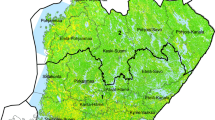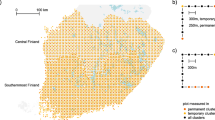Abstract
Many national forest inventories (NFI) use auxiliary data to increase the precision of estimates. Typically, this is accomplished via stratified estimation techniques that rely on assignment of similar sample plot observations to strata constructed with the goal of lowering the variance of estimates. While early applications of stratification used strata constructed from photo-interpretation of aerial photography, current technology makes using wall-to-wall digital map information more appealing due to automated processing capabilities; however, there is generally a reduction in classification accuracy in comparison with photo-interpretation and a concomitant decrease in the precision of estimates. While most established NFI have permanent plots and employ post-stratification (PS) with stratum weights known from a map, it is unclear what are the compromises compared to using a photo-interpretation (PI) approach. In this study, differences in cost and precision were evaluated for post-stratification using strata derived from a digital map and double sampling for post-stratification (DSPS) with strata created from PI of aerial imagery. It was found that DSPS consistently provided better precision than PS for estimates of total biomass and forestland area with approximately 13 PI points per sample plot, which incurred a cost increase equivalent to 0.5% per ground plot. Increasing the number of PI points per plot resulted in further gains in precision, with cost increases proportional to the PI intensity. To attain specific precision goals, DSPS was generally less costly than increasing the sample size under PS, although the PS design was more cost-effective if the PI intensity was too low. The results of this study provide a decision framework for inventory planners considering sampling designs that rely on post-stratified estimation.



Similar content being viewed by others
References
Bechtold WA, Scott CT (2005) The forest inventory and analysis plot design. In: Bechtold WA, Patterson PL (eds) The enhanced forest inventory and analysis program—national sampling design and estimation procedures. U.S. Department of Agriculture, Forest Service, Southern Research Station, Gen. Tech. Rep. SRS-80, Asheville, pp 37–52
Bickford CA (1952) The sampling design used in the forest survey of the Northeast. J For 50(4):290–293
Brown JP, Westfall JA (2012) An evaluation of the properties of the variance estimator used by FIA. In: McWilliams W, Roesch FA (eds) Monitoring across borders: 2010 joint meeting of the forest inventory and analysis (FIA) symposium and the southern mensurationists. Monitoring Across Borders: 2010 Joint Meeting of the Forest Inventory and Analysis (FIA) Symposium and the Southern Mensurationists, Asheville, pp 53–58
Cochran WG (1977) Sampling techniques, 3rd edn. Wiley, New York
De Gruijter J, Brus DJ, Bierkens MF, Knotters M (2006) Sampling for natural resource monitoring. Springer, Berlin
De Vries PG (1986) Sampling theory for forest inventory: a teach-yourself course. Springer, Berlin
Durbin J (1969) Inferential aspects of the randomness of sample size in survey sampling. In: Johnson NL, Smith H Jr (eds) New developments in survey sampling. Wiley, New York, pp 629–651
Frayer WE, Furnival GM (1999) Forest survey sampling designs: a history. J For 97(12):4–10
Gregoire TG, Ringvall AH, Ståhl G, Næsset E (2016) Conditioning post-stratified inference following two-stage, equal-probability sampling. Environ Ecol Stat 23(1):141–154
Hansen MH, Wendt DG (2000) Using classified landsat thematic mapper data for stratification in a statewide forest inventory. In: McRoberts RE, Reams GA, Van Deusen PC (eds) Proceedings of the first annual forest inventory and analysis symposium. St. Paul, MN: U.S. Department of Agriculture, Forest Service, North Central Research Station, General Technical Report. NC-213, pp 20–27
Holt D, Smith T (1979) Post stratification. J R Stat Soc Series A (General) 142(1):33–46
Homer CG, Dewitz JA, Yang L, Jin S, Danielson P, Xian G, Coulston J, Herold ND, Wickham JD, Megown K (2015) Completion of the 2011 national land cover database for the conterminous United States-representing a decade of land cover change information. Photogram Eng Rem Sens 81(5):345–354
Kangas A, Maltamo M (eds) (2006) Forest inventory: methodology and applications. Springer, Dordrecht
Köhl M, Magnussen SS, Marchetti M (2006) Sampling methods, remote sensing and GIS multiresource forest inventory. Springer, Berlin
Köhl M, Lister A, Scott CT, Baldauf T, Plugge D (2011) Implications of sampling design and sample size for national carbon accounting systems. Carbon Balance Manag 6(1):10
Lam TY, Kleinn C, Coenradie B (2011) Double sampling for stratification for the monitoring of sparse tree populations: the example of populus euphratica Oliv. forests at the lower reaches of Tarim River, Southern Xinjiang, China. Environ Monit Assess 175(1):45–61
Lister A, Scott C (2009) Use of space-filling curves to select sample locations in natural resource monitoring studies. Environ Monit Assess 149(1–4):71–80
McRoberts RE, Nelson MD, Wendt DG (2002) Stratified estimation of forest area using satellite imagery, inventory data, and the k-nearest neighbors technique. Remote Sens Environ 82:457–468
McRoberts RE, Næsset E, Gobakken T (2013) Inference for lidar-assisted estimation of forest growing stock volume. Remote Sens Environ 128:268–275
McRoberts RE, Næsset E, Gobakken T (2016) The effects of temporal differences between map and ground data on map-assisted estimates of forest area and biomass. Ann For Sci 73:839–847
Reams GA, Smith WD, Hansen MH, Bechtold WA, Roesch FA, Moisen GG (2005) The forest inventory and analysis sampling frame. In: Bechtold WA, Patterson PL (eds) The enhanced forest inventory and analysis program—national sampling design and estimation procedures. U.S. Department of Agriculture, Forest Service, Southern Research Station, General Technical Report. SRS-80, Asheville, pp 21–36
Saborowski J, Cancino J (2007) About the benefits of poststratification in forest inventories. J For Sci 53(4):139–148
Scott CT, Bechtold WA, Reams GA, Smith WD, Westfall JA, Hansen MH, Moisen GG (2005) Sample based estimators used by forest inventory and analysis national information management system. In: Bechtold WA, Patterson PL (eds) The enhanced forest inventory and analysis program—national sampling design and estimation procedures. U.S. Department of Agriculture, Forest Service, Southern Research Station, General Technical Report. SRS-80, Asheville, pp 43–67
Stephan FF (1945) The expected value and variance of the reciprocal and other negative powers of a positive Bernoullian variate. Ann Math Stat 16(1):50–61
Tomppo E, Olsson H, Ståhl G, Nilsson M, Hagner O, Katila M (2008) Combining national forest inventory field plots and remote sensing data for forest databases. Remote Sens Environ 112(5):1982–1999
U.S. Forest Service (2012) National core field guide: version 6.0. Vol. 1: field data collection procedures for phase 2 plots. https://www.fia.fs.fed.us/library/field-guides-methods-proc/docs/2013/Core%20FIA%20P2%20field%20guide_6-0_6_27_2013.pdf. Accessed 15 June 2018
USDA-FSA-APFO (2016) National agriculture imagery program (NAIP) 2015 for Pennsylvania. http://www.pasda.psu.edu/uci/DataSummary.aspx?dataset=3183. Accessed 7 March 2018
Valliant R (1993) Poststratification and conditional variance estimation. J Am Stat Assoc 88(421):89–96
Wayman JP, Wynne RH, Scrivani JA, Reams GA (2001) Landsat TM-based forest area estimation using iterative guided spectral class rejection. Photogram Eng Remote Sens 67(10):1155–1166
Westfall JA, Patterson PL, Coulston JW (2011) Post-stratified estimation: with-in strata and total sample size recommendations. Can J For Res 41:1130–1139
Westfall JA, Lister AJ, Scott CT (2016) Precision and cost considerations for two-stage sampling in a panelized forest inventory design. Environ Monit Assess 188:11
Acknowledgements
The authors are grateful to the associate editor, Dr. Tim Gregoire, and an anonymous reviewer for their insightful comments that resulted in considerable improvement to the paper.
Author information
Authors and Affiliations
Corresponding author
Ethics declarations
Conflict of interest
The authors declare that they have no conflict of interest.
Additional information
Communicated by Arne Nothdurft.
Publisher's Note
Springer Nature remains neutral with regard to jurisdictional claims in published maps and institutional affiliations.
Rights and permissions
About this article
Cite this article
Westfall, J.A., Lister, A.J., Scott, C.T. et al. Double sampling for post-stratification in forest inventory. Eur J Forest Res 138, 375–382 (2019). https://doi.org/10.1007/s10342-019-01171-9
Received:
Revised:
Accepted:
Published:
Issue Date:
DOI: https://doi.org/10.1007/s10342-019-01171-9




